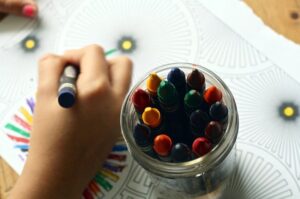Importance of Art on the Mental Health of Children by Joseph Stevenson
 The mental health of children has unfortunately worsened by 22% in the past couple of years.
The mental health of children has unfortunately worsened by 22% in the past couple of years.
With numerous stressors on the news and at school and home, our kids would greatly benefit from mental health support. And one of the most beneficial forms of mental healing can be found through creating art.
Keep reading to discover the importance of art for children’s mental well-being……..
Nonverbal Communication
Even during normal everyday activities, kids experience a vivid array of emotions. Some of these emotions may feel quite new to the child.
Although they are emotionally complex, kids sometimes lack the words to explain these feelings to others. As a result, they get frustrated. This can lead to acting out and tantrums.
Perhaps they want to seek reassurance or help, but they don’t know how to say it. This is where art serves as a valuable tool.
Art is an extremely effective form of nonverbal communication. Using colors, symbols, and shapes, kids are able to bring their feelings into the world. As Fred Rogers said, “Anything that’s human is mentionable, and anything that is mentionable can be more manageable.”
Even to the untrained eye, it’s often easy to read the raw emotion in a child’s art. Once kids put their feelings on paper, they are better able to deal with those feelings.
Adults can ask questions for clarification, and to open up a discussion. This dissipates frustration and builds relationships of trust.
Art Is Meditative
There are rising numbers of people, both adults and children, who use art as a form of meditation. This is because creating art provides many of the same diverse benefits.
For example, art and meditation both require a child to focus or empty their mind. This develops mental discipline. With mental discipline often comes the increased ability to cope with environmental stressors.
While a child creates art, their brain empties of daily worries and cares. While creating, they are living fully in the present. This decreases negative emotions and restores a sense of life balance. Both art and meditation promote a sense of well-being and overall life satisfaction, and this feeling of calm can linger for the rest of the day.
Art Is Healing
Art can exert a powerful healing effect on the mental health of children. This is because art connects the mind and the body, encouraging them to sync. This leads to a sense of grounding, a feeling of connection with yourself.
There is evidence that using both hands to make art activates both halves of your brain. This often proves to be a powerful tool in counteracting unpleasant feelings and stress.
Art does not need to be analyzed by a psychiatrist or picked apart for meaning. The act of creating art is healing in itself.
Furthermore, art can be created in a non-confrontational environment. In a familiar setting such as an art class or their own home, kids don’t feel put on the spot. They will open up and let their imagination play, without fear of judgment.
This may promote self-esteem as kids learn to trust themselves. Creativity lives in us, and as kids create art, they learn to nurture it and value it as a skill. A child’s self-value increases with every piece of art they make.
Art also teaches valuable decision-making skills which carry over into other parts of their lives. It has even proven to improve grades in classes like reading, writing, and math.
Art Promotes Socialization
One aspect of the pandemic that hit kids hardest was the isolation. Kids are accustomed to talking with friends and teachers all day. They used to be able to do team sports and have playdates after school. Now more than ever, we see that opportunities for socialization are key to the mental well-being of children. Art can provide that outlet for socializing.
This could involve attending an event hosted by an artist. These events enable kids to meet creative adults who share their passion for painting, drawing, or sculpting. They can discuss their own art and learn new techniques. These events also provide affirmation. They see that their art is valuable as a hobby or a career. They also may gain role models and mentors.
Art can also promote socialization among their own age group. Through art classes and shows, kids form bonds with fellow young artists. They build a community of their peers. This provides a sense of belonging that greatly promotes a better state of mental health.
Importance of Art for Empathy
When children create art, they practice seeing from other points of view. This encourages an ability to empathize. This ability will carry over from childhood to adulthood, serving them well all their lives.
Art provides a constructive outlet for pain and hurt feelings. Instead of trying to retaliate, kids learn that art can transform inner turmoil into a thing of beauty.
When kids view someone else’s art, they realize other people are going through similar challenges and struggles. They recognize emotions that they have felt. They may even take note of how their own actions have affected others.
If a child can see how they may have hurt another person, they build an important sense of responsibility for their own actions. They learn how to behave in the future to avoid hurting others. This enables them to create lasting bonds of friendship and cooperation.
Encourage Youth to Make Art
For a wide variety of reasons, creating art is beneficial to increasing and maintaining mental health for children. It provides a form of meditation and an expressive outlet for difficult feelings.It also promotes socialization with other children and adults who share their interests. Art can even build empathy skills that will serve them well their entire lives.
 Joseph Stevenson is an artist and the author of the best-selling “How to Draw Anime” and “How to Draw Manga” children’s book series, as well as the books “How to Draw Figures Simple Anatomy, People, & Forms for Beginners” and “How to Draw Animals: Learn to Draw Animals Using Basic Shapes and Lines,” among many others. He is an advocate of art education and currently resides in Southern Utah with his wife and four children. Visit josephstevenson.com.
Joseph Stevenson is an artist and the author of the best-selling “How to Draw Anime” and “How to Draw Manga” children’s book series, as well as the books “How to Draw Figures Simple Anatomy, People, & Forms for Beginners” and “How to Draw Animals: Learn to Draw Animals Using Basic Shapes and Lines,” among many others. He is an advocate of art education and currently resides in Southern Utah with his wife and four children. Visit josephstevenson.com.
Tags: importance of art















